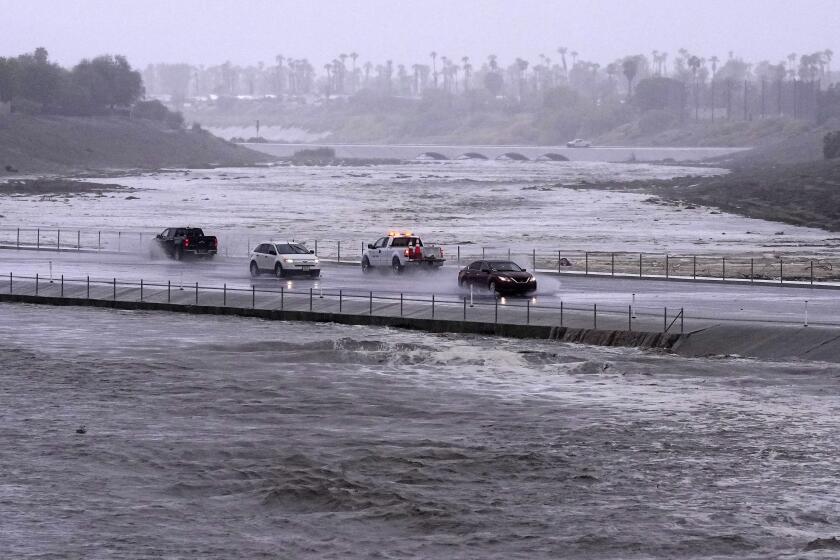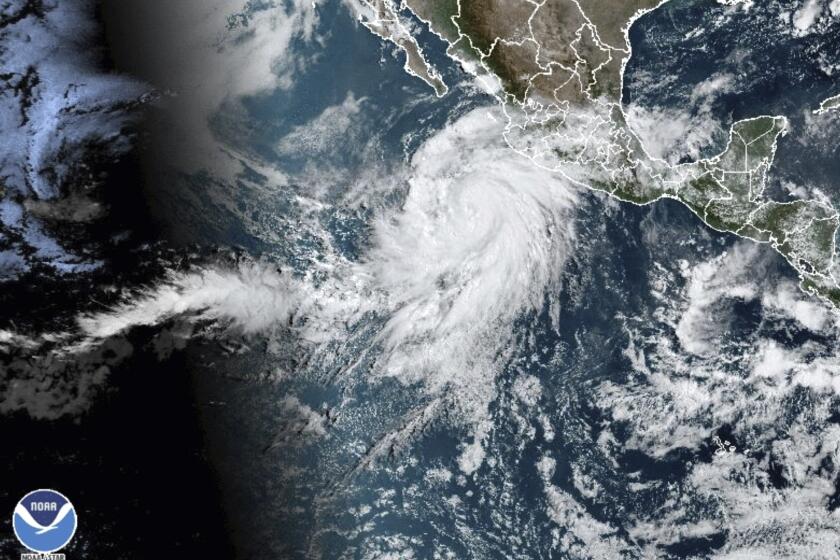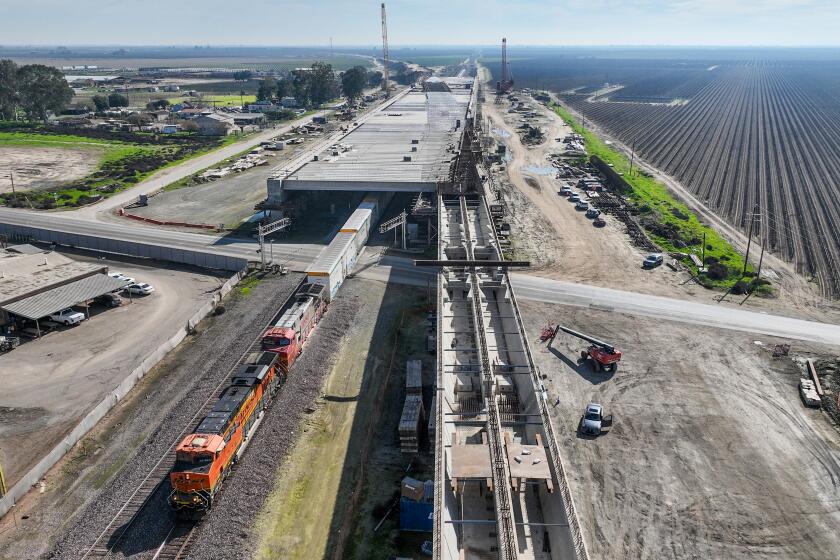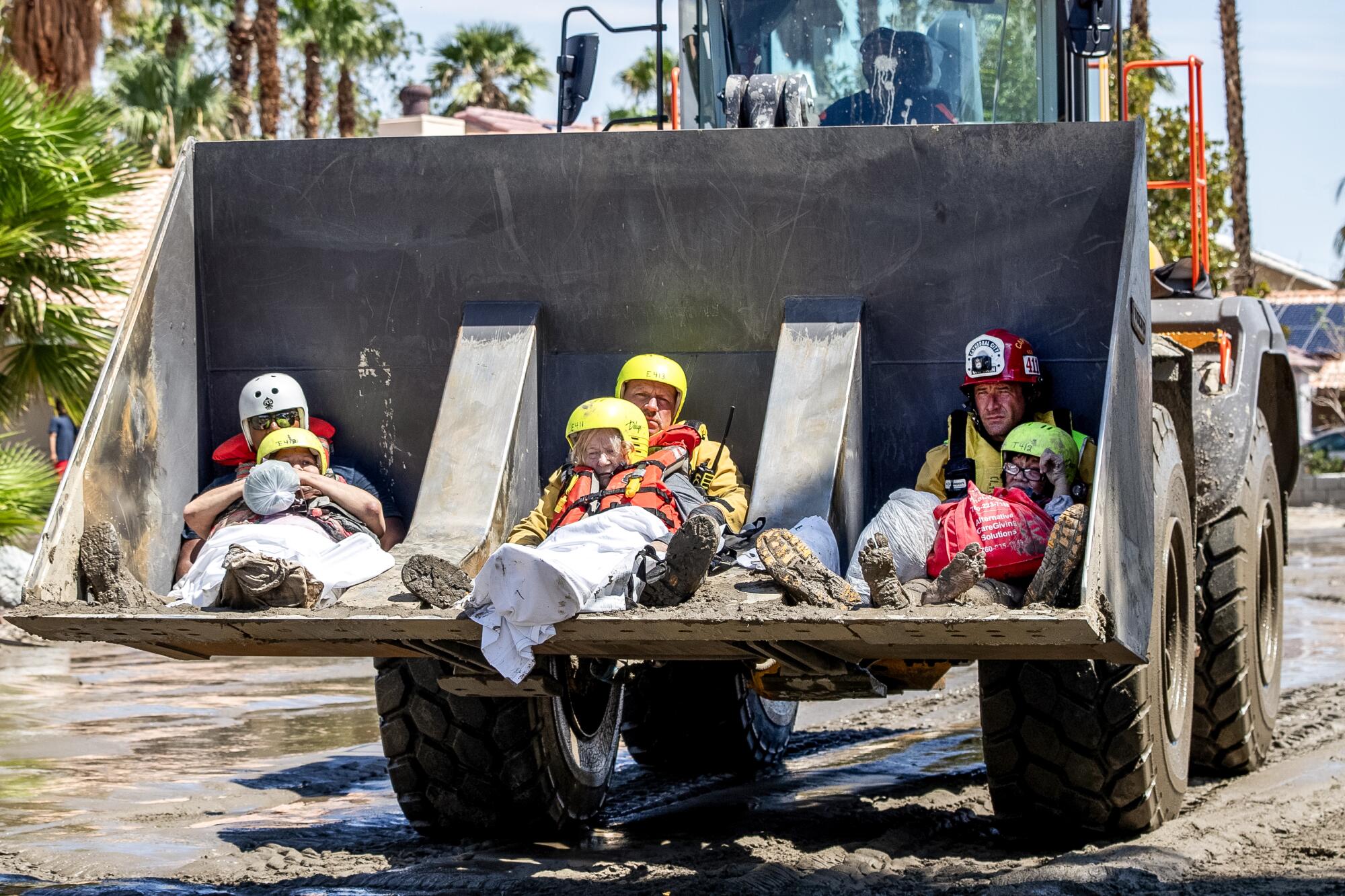
- Share via
PALM SPRINGS — Palm Springs and the Coachella Valley were digging out Monday from intense flooding and mudflows following Tropical Storm Hilary, which inundated roads and cut off the region’s key freeway, Interstate 10, for many hours.
Riverside County declared a local emergency in the wake of the storm that officials deemed would last at least a week as cleanup efforts get underway.
The first tropical storm to hit Los Angeles in 84 years dumped record rainfall and turned streets into muddy, debris-swollen rivers.
At 9:30 a.m. Monday, there was a line of 14 tractor-trailers camped out on Date Palm Drive in Cathedral City, trying to get on the 10 Freeway, which was closed from Haugen-Lehmann Way to Bob Hope Drive.
Trameeka Reid, 35, a truck driver with Stevens Transport, left Missouri on Aug. 17 and was heading to Los Angeles County to drop off a load. She was supposed to maker her delivery at 4 a.m. Monday, but she had to stop and hunker down Sunday afternoon because of the storm.
“This area was affected a little more than I anticipated,” she said.
Reid and at least 100 other truck drivers circled Cathedral City after midnight, looking for a detour to get past the I-10 closure. “But everything was either flooded or getting to the point of where the mudslides were starting to happen,” she said.
The trucks tried circling toward Highway 111, but that was shut down too, Reid said. Eventually, the rigs all parked on Date Palm Drive around 2 a.m.
On Monday morning, she was keeping a close eye on communications from the California Highway Patrol, waiting to get back on the road. She tried looking for detours, but nothing was promising, she said.
Besides the 10 Freeway, the storm left numerous roads and highways closed, including State Route 62 from Godwin Road to State Route 177, and Gene Autry Trail. Both directions of the 10 were reopened by 2 p.m., the city of Palm Springs said, however eastbound traffic was being diverted off the freeway at Date Palm Drive, north to Varner, and east on Varner to renter the freeway at Monterey.
Even after some floodwaters had receded, silt and debris still covered a few roadways.
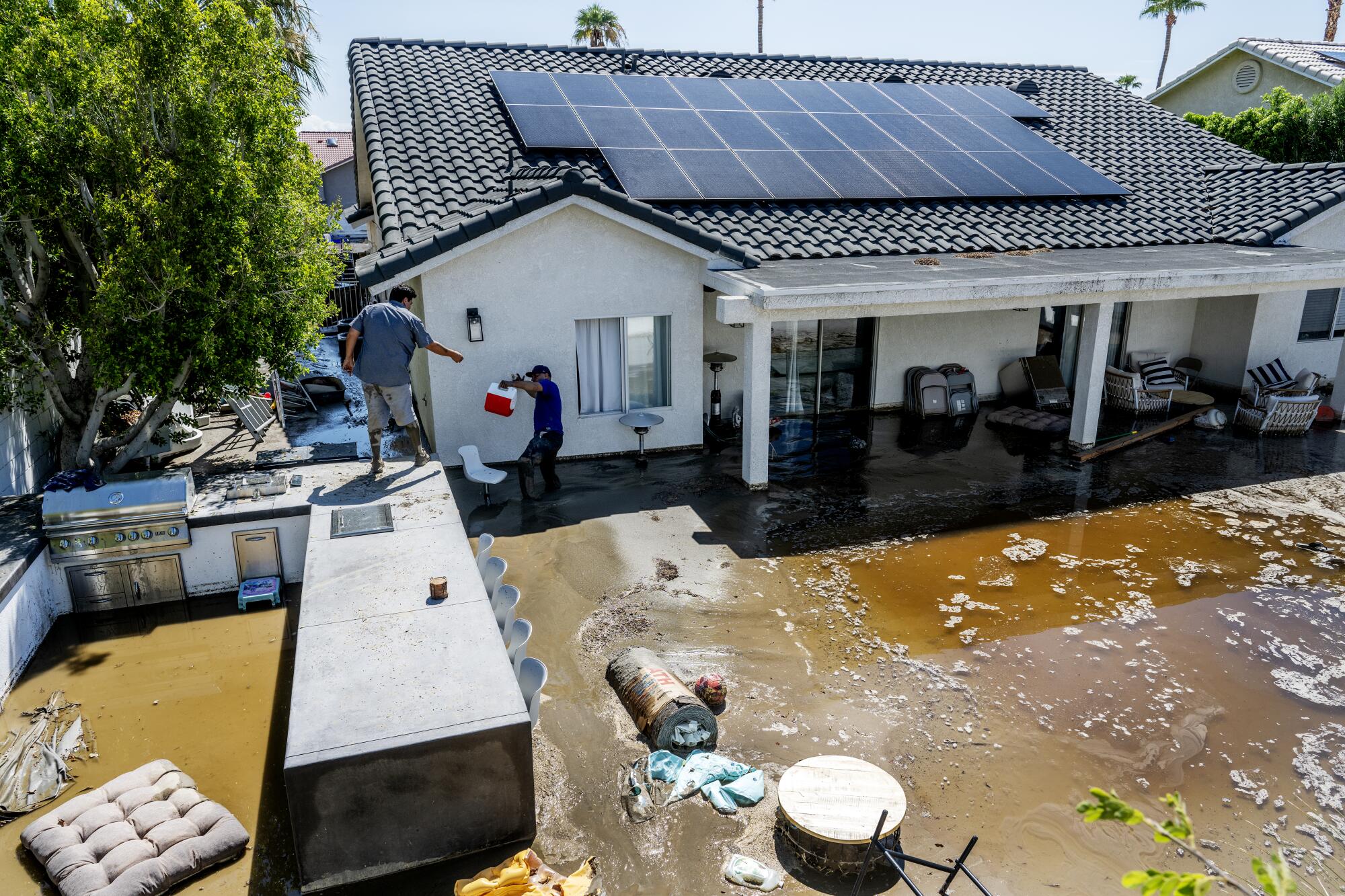
Palm Springs averages 4 to 5 inches of rainfall per year, said Elizabeth Adams, a meteorologist with the National Weather Service in San Diego.
Hilary unleashed more than half of that Sunday. The Coachella Valley received 2 to 4 inches of rain at lower elevations, including in Palm Springs and Indio, and about 4 to 6 inches farther west, the weather service said.
Ahead of the storm, more than 40,000 sandbags were distributed to residents at fire stations, said Daniel DeSelms, Palm Springs’ emergency management coordinator. Each household was allotted 10 bags.
“This storm has been unlike anything our community has faced before. We want to thank our residents, businesses and members of the community for their patience as we work to clean up downed trees and mitigate flooding,” the city of Palm Desert said on Facebook.
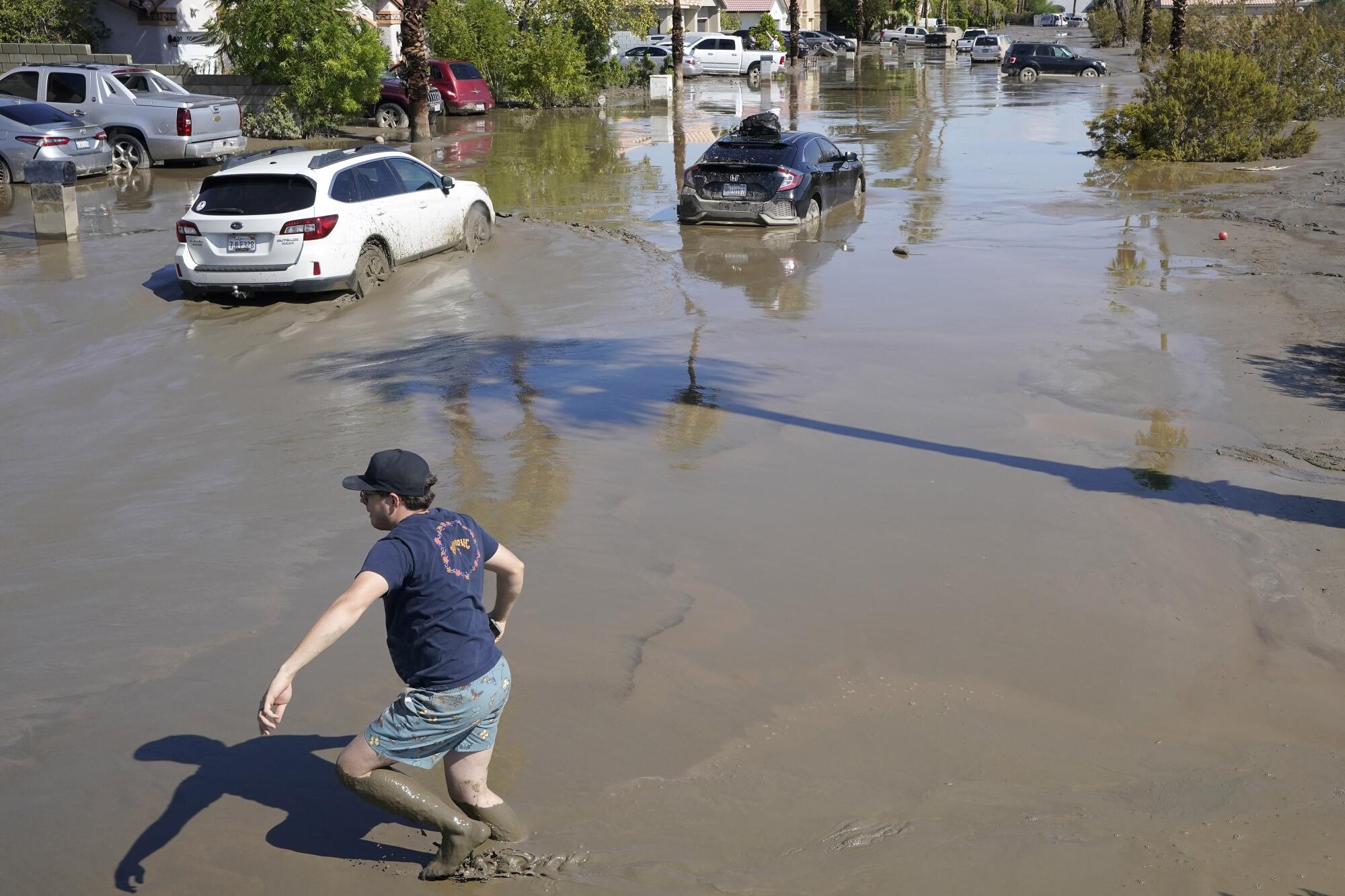
The city of Palm Springs issued an updated map of all street and highway closures.
Officials are still trying to tally the damage following record rainfall. Some cities in the Coachella Valley reported that streets were beginning to reopen as floodwaters receded, but many were still closed.
The Palm Springs Fire Department helped respond to calls for swift-water rescues in neighboring Cathedral City “all night,” public information officer Nathan Gunkel said Monday.
Tropical Storm Hilary blew past daily rainfall records across Southern California, “just smashing” records across L.A. and Ventura counties.
The flooding was taking a particular toll on the region’s workers.
Luz Gallegos, executive director of the nonprofit group TODEC, said teams were on call Monday to assist families throughout the Inland Empire and Coachella Valley. On Sunday night, TODEC’s Coachella team helped coordinate transportation with the county for several families in Thermal and Mecca who needed to get to a shelter.
At the Oasis Mobile Home Park on Sunday in Thermal, she said, residents were reporting high winds and patio covers that were flying off.
“Right now, it’s mostly recovery and trying to figure out where folks are at,” Gallegos said Monday morning. The main concern they are hearing, she said, is from farmworkers who are unable to work. “We’re in that mode to see what we can fundraise.”

Gallegos was ready to head to a ranch on the west end of the county at daybreak. Migrant workers needed rain gear.
Since Thursday night, TODEC has received more than 2,000 calls to its hotline. Many people have called in for assistance. A lot of calls have been from farmworkers concerned about losing work because of the rain, said Ariana Borroel, who oversees the hotline.
“Because many of them are undocumented, they don’t have access to unemployment, leaving them to have to work on a daily basis,” Borroel said. “Their panic is that if they stop working, they’re not able to provide for their family and themselves.”
An unprecedented tropical storm watch has been issued for Southern California as Hilary barrels north toward the United States.
Among those worrying was Martina Zacarias, a 20-year resident at Oasis Mobile Home Park in Thermal. She and her husband, both farmworkers, last worked Friday, helping bag dates to protect them from the upcoming storm.
As the rain poured down Sunday, sending rivulets of water cascading into her driveway, Zacarias said she was more worried about her work hours.
“We’re not going to be able to work until it all dries,” Zacarias said. But a lack of work doesn’t mean the bills stop coming. And they have a $675 rent to think about.
“We always need to be working. If we don’t work, we don’t have food.”
Times staff writers Alexandra E. Petri, Summer Lin and Rong-Gong Lin II contributed to this report.
More to Read
Sign up for Essential California
The most important California stories and recommendations in your inbox every morning.
You may occasionally receive promotional content from the Los Angeles Times.



